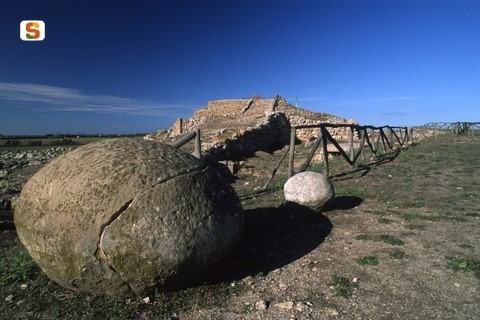The facies of San Ciriaco in Li Muri
Today we tend to culturally attribute the necropolis of Li Muri to the facies of San Ciriaco, which is placed chronologically between the Middle Neolithic and the Late Neolithic periods and which was identified for the first time in the prehistoric built-up area of San Ciriaco of Terralba.
The most significant sites of this culture are those of Cuccuru S'Arriu-Cabras, Sant'Iroxi-Decimoputzu, Contraguda-Perfugas and Monte d’Accoddi-Sassari (fig. 1).

The San Ciriaco ceramics stand out because of their careful workmanship; they have no decorations or they have engraved, etched or graffiti patterns consisting of lines, concentric circles and small dots enclosed inside triangles (fig. 2).

The small stone containers are also attributable to this cultural facies, among which we see the soapstone cup found in the stone cista of circle tomb n. 1 in the necropolis of Li Muri, which together with other items was part of the deceased’s funeral goods (fig. 3).

A characteristic aspect of the San Ciriaco phase is a type of female statuette identified as a representation of the Mother Goddess (fig. 4).

After the period of the San Ciriaco facies, we have the phase called San Michele, or of Ozieri, which takes its name from the cave where archaeologists unearthed a group of vases which appear for the first time within the ceramic repertoire of Sardinian Neolithic and which are very similar to those found in Eastern Mediterranean environments.
There are also connections with the cultures of Western Europe, proof of the existence of a large network of trade exchanges throughout the Mediterranean, including because of the central role which Sardinia held in the obsidian trade.
Bibliografia
- ANTONA A., Arzachena. Pietre senza tempo, Sassari 2013, pp. 72-83.
- LUGLIÈ C., La ceramica di facies S. Ciriaco nel Neolitico superiore della Sardegna: evoluzione interna e apporti extrainsulari, in AA.VV., Atti della XXXV Riunione Scientifica IIPP, Vol. II, 2003, pp. 723-733.
- SANTONI V., Il Neolitico superiore di Cuccuru S’Arriu di Cabras (Oristano), in AA.VV., La ceramica nel Sinis dal neolitico ai giorni nostri, Atti del II Convegno di Studi, “La ceramica racconta la storia”, Oristano-Cabras, 25-26 ottobre 1996, Cagliari 1998, pp. 97-105.

 VR
VR